Applied Surface Science: 0D/2D stacked CuO/V2C MXene heterostructure significantly improves the dielectric response of composite materials
QQ Academic Group: 1092348845
Detailed
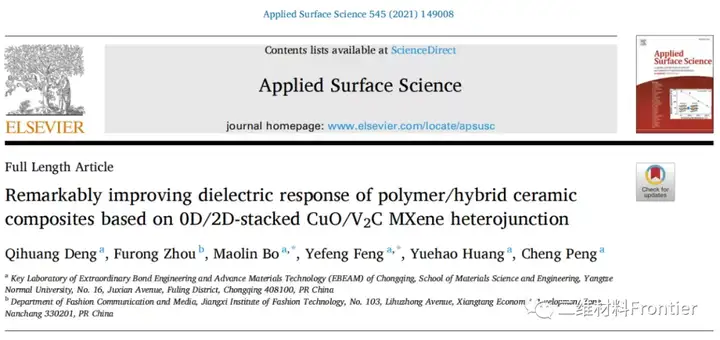
1. Article overview
High-density polymer/ceramic composites require high dielectric response and electrical insulation. In polymer composites with semiconductors, the dielectric response is low. In order to balance the high dielectric constant and breakdown strength, the article studied the preparation of polymer matrix composites with re-synthesized V2C MXene-Cuo hybrid particles. The study found that the high dielectric response of the composites was attributed to the ceramic/ceramic heterogeneity. The strong electron polarization and high insulation at the mass junction are due to the electron trap effect induced by fluorine. First-principles calculations verified the electron transfer mechanism at the V2C/CuO van der Waals heterojunction. Compared with the polymer/CuO binary composite, the comprehensive electrical properties of the polymer/V2C-CuO ternary composite (significantly Improve dielectric response and slight insulation damage). The ternary composite containing 10wt%V2C-CuO has a high dielectric constant of 89, a low dielectric loss of 0.23, a low conductivity of 6.8×10−7Sm−1 at 100Hz, and a high breakdown strength of 204MVm−1. The research of the article makes it possible to easily prepare cutting-edge nanocomposite dielectrics.
Two, graphic guide
High-density polymer/ceramic composites require high dielectric response and electrical insulation. In polymer composites with semiconductors, the dielectric response is low. In order to balance the high dielectric constant and breakdown strength, the article studied the preparation of polymer matrix composites with re-synthesized V2C MXene-Cuo hybrid particles. The study found that the high dielectric response of the composites was attributed to the ceramic/ceramic heterogeneity. The strong electron polarization and high insulation at the mass junction are due to the electron trap effect induced by fluorine. First-principles calculations verified the electron transfer mechanism at the V2C/CuO van der Waals heterojunction. Compared with the polymer/CuO binary composite, the comprehensive electrical properties of the polymer/V2C-CuO ternary composite (significantly Improve dielectric response and slight insulation damage). The ternary composite containing 10wt%V2C-CuO has a high dielectric constant of 89, a low dielectric loss of 0.23, a low conductivity of 6.8×10−7Sm−1 at 100Hz, and a high breakdown strength of 204MVm−1. The research of the article makes it possible to easily prepare cutting-edge nanocomposite dielectrics.
Two, graphic guide
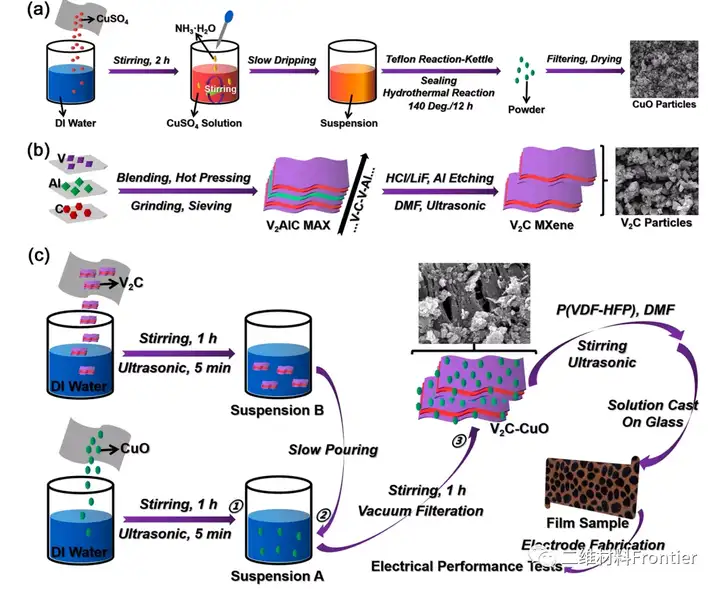
Figure 1. Scheme preparation steps of (a) copper oxide, (b) V2C and (c) mixed ceramics and composite materials.
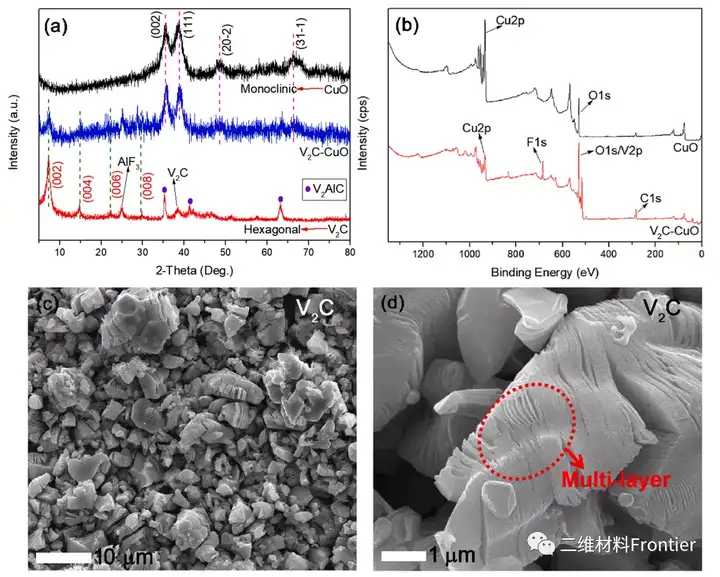
Figure 2. (a) XRD of V2C, copper oxide and hybrid ceramics, (b) XPS copper oxide and hybrid ceramics, (c) V2C low magnification scanning electron microscope and (d) V2C high magnification scanning electron microscope.
The XPS full spectrum of copper oxide and mixed ceramics shows that in copper oxide, the signals of 933eV and 529eV are assigned to Cu2p and o1s. In the mixed ceramics, Cu2p and O1s signals were detected, indicating the presence of copper oxide in the mixed ceramics. The signals of 5295eV and 289eV come from V2p and C1 of V2C in the hybrid ceramic.
The XPS full spectrum of copper oxide and mixed ceramics shows that in copper oxide, the signals of 933eV and 529eV are assigned to Cu2p and o1s. In the mixed ceramics, Cu2p and O1s signals were detected, indicating the presence of copper oxide in the mixed ceramics. The signals of 5295eV and 289eV come from V2p and C1 of V2C in the hybrid ceramic.

Figure 3. (a) Copper oxide low power scanning electron microscope, (b) Copper oxide magnifying scanning electron microscope, (c) Hybrid ceramic low power scanning electron microscope, (d) Hybrid ceramic high power scanning electron microscope.
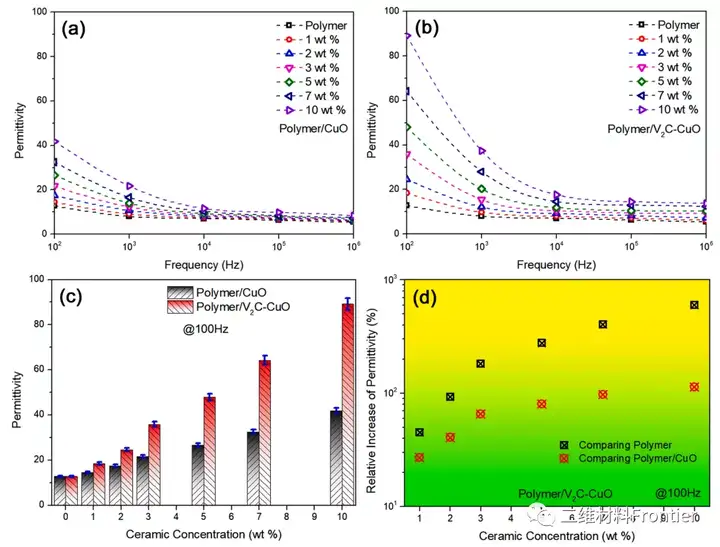
Figure 4. (a) Dielectric constant frequency spectrum of the binary system, (b) Dielectric constant frequency spectrum of the ternary system, (c) The relationship between the dielectric constant of the 100Hz ternary system and the ceramic content at 100Hz, (d) The ternary system and Compared with the binary system, the dielectric constant of the polymer at 100 Hz is relatively increased.
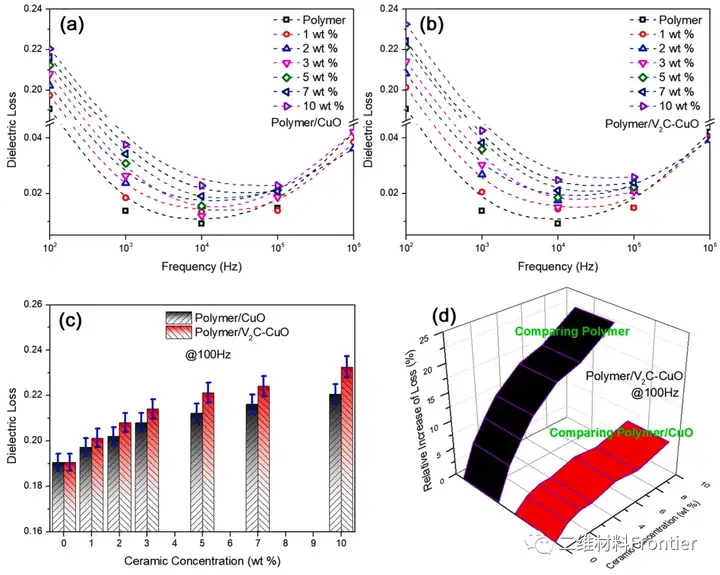
Figure 5. (a) Dielectric loss spectrum of binary system, (b) Dielectric loss spectrum of ternary system, (c) Relationship between dielectric loss of dual system and ceramic content at 100Hz, (d) Ternary system and polymer and Compared with the binary system, the loss at 100 Hz is relatively increased.
3. Full text summary
V2C and copper oxide particles were used to prepare synthetic V2C-Cuo hybrid particles. Compared with copper oxide, it exhibits a higher high dielectric response and induces enhanced interface polarization, which greatly improves the dielectric constant of the ternary system. The prepared polymer-based ternary composite film is used as the dielectric. Compared with the polymer/CuO binary system, the ternary system exhibits increased dielectric constant, slightly increased dielectric loss and conductivity, and slightly reduced breakdown strength. Finally, the article proposes the study of the high dielectric response of the ternary system based on the strong electronic polarization of the interface copper and F of the ceramic/ceramic van der Waals heterojunction. In summary, the high dielectric constant of the ternary system should be derived from the polarization of the polymer/V2C interface, the electronic polarization at the V2C/CuO interface, and the electron-hole dipole in the copper oxide. High breakdown performance should be based on low ceramic/ceramic (polymer/V2C) interface leakage conductivity and uniform field distribution. 10wt% ternary composite ceramics have a high dielectric constant ~89, low dielectric loss ~0.23, 100Hz low conductivity ~6.8×10−7sm−1, and high breakdown strength ~204mvm−1. It is revealed that there is a strong synergy between V2C and copper oxide.
Article link:
https://doi.org/10.1016/j.apsusc.2021.149008
This information is sourced from the Internet for academic exchanges only. If there is any infringement, please contact us to delete it immediately.
3. Full text summary
V2C and copper oxide particles were used to prepare synthetic V2C-Cuo hybrid particles. Compared with copper oxide, it exhibits a higher high dielectric response and induces enhanced interface polarization, which greatly improves the dielectric constant of the ternary system. The prepared polymer-based ternary composite film is used as the dielectric. Compared with the polymer/CuO binary system, the ternary system exhibits increased dielectric constant, slightly increased dielectric loss and conductivity, and slightly reduced breakdown strength. Finally, the article proposes the study of the high dielectric response of the ternary system based on the strong electronic polarization of the interface copper and F of the ceramic/ceramic van der Waals heterojunction. In summary, the high dielectric constant of the ternary system should be derived from the polarization of the polymer/V2C interface, the electronic polarization at the V2C/CuO interface, and the electron-hole dipole in the copper oxide. High breakdown performance should be based on low ceramic/ceramic (polymer/V2C) interface leakage conductivity and uniform field distribution. 10wt% ternary composite ceramics have a high dielectric constant ~89, low dielectric loss ~0.23, 100Hz low conductivity ~6.8×10−7sm−1, and high breakdown strength ~204mvm−1. It is revealed that there is a strong synergy between V2C and copper oxide.
Article link:
https://doi.org/10.1016/j.apsusc.2021.149008
This information is sourced from the Internet for academic exchanges only. If there is any infringement, please contact us to delete it immediately.
- Previous: ACS Appl. Mater. Inter
- Next: A Rising 2D Star: Nove


 Academic Frontier
Academic Frontier